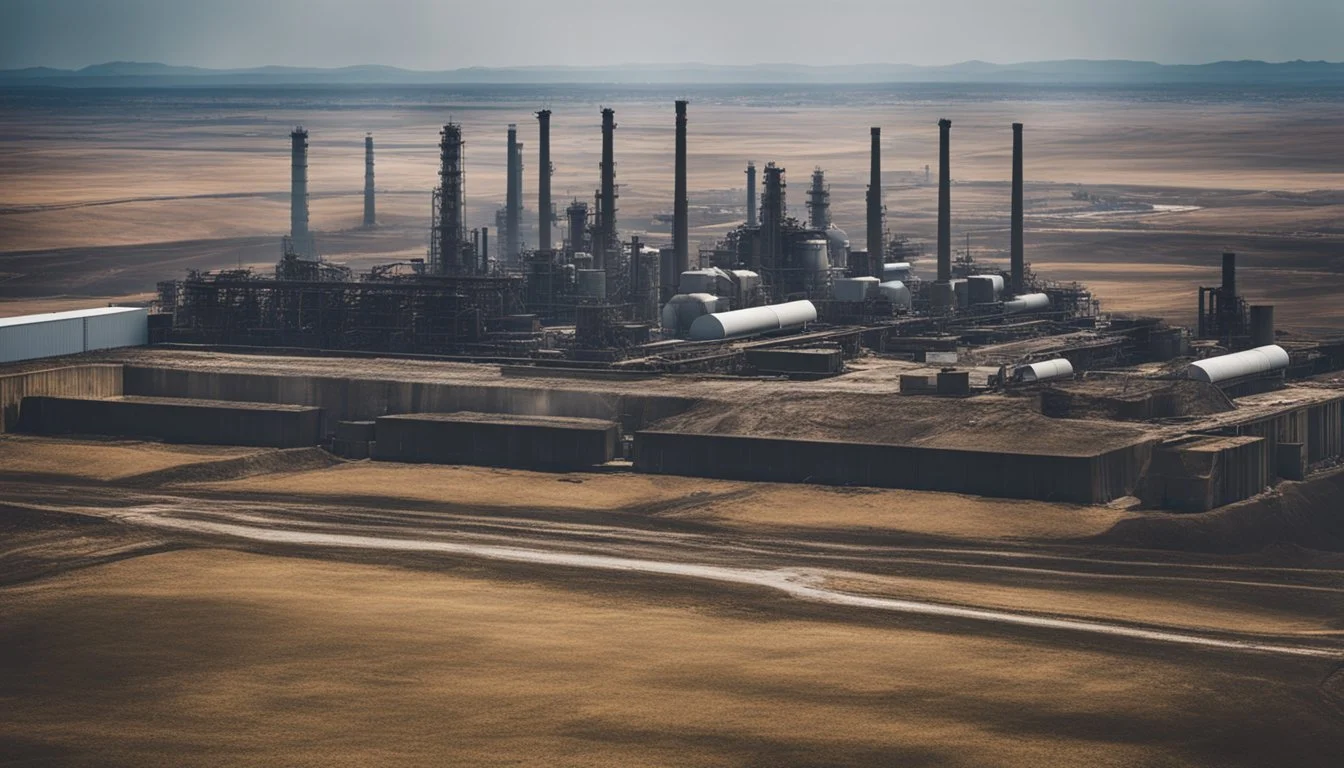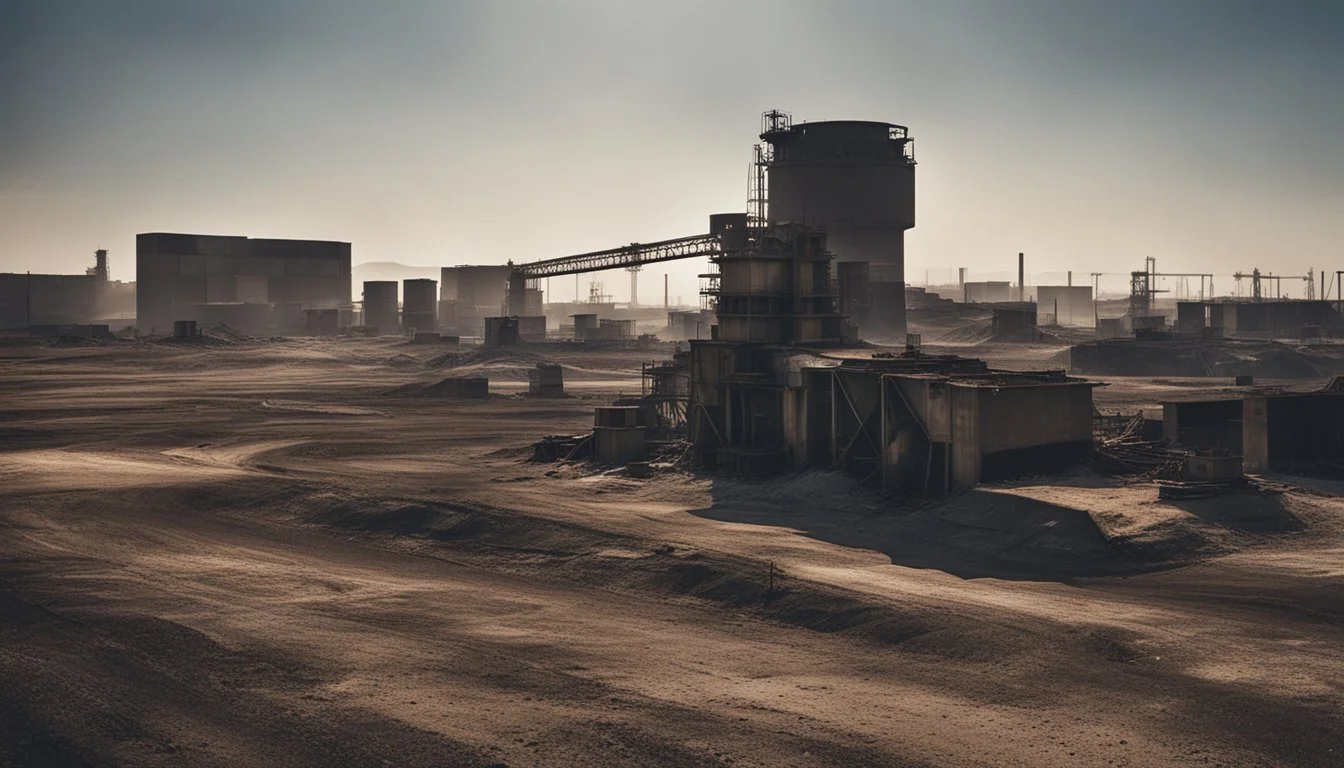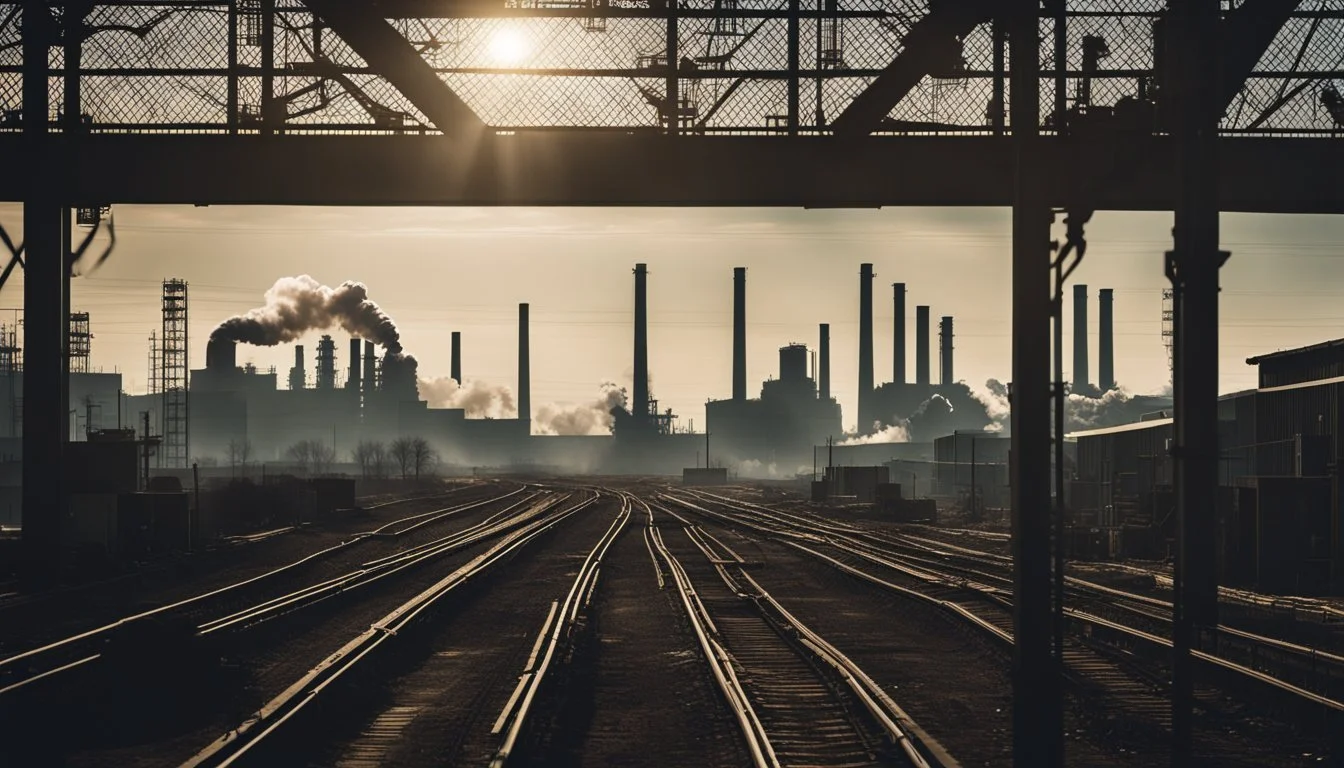Nikolaus Geyrhalter: Contemplating the Anthropocene Era Through Cinematic Lens
Humans have long impacted the Earth, but the term "Anthropocene" crystallizes the concept of humanity as a major geological force. Nikolaus Geyrhalter's 2019 film "Earth" delves deeply into this idea, presenting the Anthropocene through vivid, unflinching portrayals of the scars left on the planet's crust by human activity. "Earth" daringly confronts the viewer with the visceral reality of modern progress and its toll on our environment.
Geyrhalter's journey through various excavation sites across Europe and North America exposes the ongoing alteration of the Earth's delicate layer. His work challenges audiences to reflect on the consequences of industrial advancements and question the sustainability of our current trajectory. The images he captures offer a stark contrast between the drive for progress and the physical wounds inflicted upon the planet.
By examining these industrial landscapes and their significance, the film "Earth" anchors itself as a critical commentary on the Anthropocene Era. It invites viewers to witness the scale of human impact, framing the current geological epoch as one defined by unprecedented environmental change, driven largely by human hands.
Nikolaus Geyrhalter: A Biographical Overview
Nikolaus Geyrhalter, born in 1972 in Vienna, Austria, is a renowned filmmaker known for his evocative documentaries. He has worn multiple hats in the film industry, working as a director, producer, writer, and cinematographer.
His career began with significant early works such as Das Jahr nach Dayton (1997) and Pripyat (1999). Both received critical acclaim.
Throughout his career, Geyrhalter has focused on thematic explorations of human impact and environmental issues. Notable films include Elsewhere (2001) and Our Daily Bread (2005).
In recent years, Geyrhalter continued to earn recognition with films like Earth (2019) and Matter Out of Place (2022). His works often combine elements of science fiction and documentary, uniquely merging reality with speculative scenarios.
Selected Filmography
The Standstill (2023)
Matter Out of Place (2022)
Earth (2019)
The Border Fence (2018)
Homo Sapiens (2016)
Over the Years (2015)
CERN (2013)
Geyrhalter's films have been showcased at various international festivals, including Berlinale Forum. He has a distinctive voice in documentary filmmaking, often highlighting societal and environmental themes.
Notable Awards
Das Jahr nach Dayton (1997)
Pripyat (1999)
Our Daily Bread (2005)
Nikolaus Geyrhalter continues to influence the documentary genre with his insightful perspectives and compelling visual narratives.
Understanding the Anthropocene Era
The Anthropocene era signifies a period where human activity has become the dominant influence on the Earth's climate and environment. This concept emerged to highlight the profound and lasting impact humans have on the planet.
Key Human Activities:
Deforestation: Large-scale tree cutting depletes forests.
Groundwater Abstraction: Intensive use of underground water resources.
Dam Construction: Alters natural water flow and ecosystems.
Scientists argue that unlike the stable Holocene era, the Anthropocene is marked by rapid environmental changes driven by industrial and agricultural developments. Human actions have pushed ecological and environmental boundaries.
The term 'Anthropocene' gained traction in the late 20th century, with significant contributions from researchers like George Perkins Marsh and Antonio Stoppani. Perkins Marsh's work emphasized human-induced global change, while Stoppani coined the term "Anthropozoic."
Filmmaker Nikolaus Geyrhalter's works, such as "Erde" (Earth, 2019), visually represent humanity's extensive modification of landscapes. His films often explore underground excavations and other sites impacted by human intervention.
The Anthropocene encourages a reassessment of environmental policies and practices. By acknowledging human impact, societies can aim for sustainable development and conservation efforts. Avoiding drastic changes in the Earth's systems ensures the planet's health for future generations.
The Cinematic Style of Geyrhalter
Nikolaus Geyrhalter's cinematic approach stands out for its unique combination of documentary and fictional elements.
He often relies on long takes and static shots, creating a contemplative experience that immerses the viewer in the visual and emotional landscape.
Minimal dialogue is a key feature in his work. Instead, he uses rich and textured imagery to communicate themes and narratives.
Geyrhalter’s style can be described as a blend of science fiction and documentary. His film Homo Sapiens exemplifies this, as it depicts a world where nature reclaims human-made environments.
The use of natural landscapes and man-made structures serves as symbolic actors in his films.
This deliberate choice of subjects contributes to a sense of timelessness and introspection.
His work often portrays decay and renewal, themes that resonate deeply with viewers and prompt contemplation about the Anthropocene era.
Geyrhalter adheres to the principles of slow cinema, focusing on meticulous and patient storytelling. This approach requires the audience to engage deeply with the visuals, as emotional and informational exchanges occur through the imagery itself.
The static shots and long durations invite viewers to observe and reflect, contrasting with the fast-paced editing commonly seen in mainstream cinema.
In summary, Nikolaus Geyrhalter's cinematic style is characterized by its visual storytelling, minimalist dialogue, and thought-provoking imagery, offering a unique lens through which to view the world and human impact on it.
Major Works in the Context of the Anthropocene
Nikolaus Geyrhalter is a filmmaker known for exploring the Anthropocene, a term describing the current geological epoch shaped by human activities.
Homo Sapiens (2016) captures abandoned spaces around the world, reflecting on humanity's impact and absence.
Erde (Earth, 2019) investigates large-scale land modification projects, showcasing the complex interplay between human activities and the planet's geology.
By focusing on objects as images, as noted by André Bazin, Geyrhalter emphasizes the visual and material aspects of our environment.
In both films, Geyrhalter utilizes a realist aesthetic to underscore the themes of human dominance and environmental change.
Themes and Motifs in Geyrhalter's Films
Nikolaus Geyrhalter's films often explore the relationship between humanity and the environment. His works delve into how human actions impact the natural world, showcasing elements of the Anthropocene Era. Geyrhalter presents a world where nature gradually reclaims spaces once dominated by human activity.
A recurring motif in his films is slow cinema. This technique emphasizes long, unhurried shots. It allows viewers to immerse themselves in the scenery and ponder the deeper implications of what they observe.
For example, in Homo Sapiens, he captures a post-apocalyptic vision where human-built structures crumble and vegetation takes over. This visual narrative suggests the transient nature of human achievements compared to the enduring force of nature.
Abendland examines life in Europe after dark. The film discusses the intersection of modern society with nighttime activities, offering a unique perspective on civilization and its rhythms.
Geyrhalter's work also touches on themes of lost human connection and desolation. His 2015 documentary Over the Years portrays the lives of individuals facing economic hardship, emphasizing the stark reality of their struggles.
Table of Themes:
Film Main Themes Homo Sapiens Human Absence, Nature's Rebirth Abendland Nighttime, Civilizational Rhythms Over the Years Economic Hardship, Human Struggle
Documentary Techniques and Narrative Approaches
Nikolaus Geyrhalter uses distinct methods to explore themes related to the Anthropocene era. His films often feature static, wordless shots that capture the transformation of landscapes without human presence, allowing the visual elements to convey the narrative.
In "Homo Sapiens," Geyrhalter constructs a narrative exclusively through images. This approach emphasizes the photographic quality of his work. The still camera serves not only as a recording device but also as a means to enhance the viewer's immersion into the depicted environments.
Key Techniques:
Static Shots: The camera remains still, creating a contemplative viewing experience.
Absence of People: The lack of human figures focuses the viewer on environmental and architectural elements.
Natural Soundscapes: Sounds like wind and rain are integral, grounding the visual experience in reality.
Geyrhalter's style aligns with the ethos of slow cinema. This method encourages viewers to engage patiently with each frame, fostering a deeper connection with the imagery. By doing so, he invites contemplation on decay, time, and the endurance of human impact on the planet.
Using these techniques, Geyrhalter's documentaries blur the lines between fiction and reality. The scenes, though real, often suggest a fictional post-apocalyptic world. This unique narrative approach informs the viewer about the potential future of human legacy on Earth.
His work is not just informative but also visually striking, making complex themes more accessible through powerful imagery and meticulous attention to detail in every frame.
Influence and Contributions
Nikolaus Geyrhalter's work has profoundly impacted documentary filmmaking, positioning him as a crucial figure in contemporary cinematic discussions. His contemplative films highlight anthropogenic effects on the environment, offering thought-provoking commentary on human existence and its implications.
Influence on Documentary Filmmaking
Geyrhalter's distinct style elevates the realm of documentary filmmaking through his use of long takes and static shots. This deliberate pacing allows viewers to deeply engage with his subjects without the distraction of commentary or overt narrative structures. In "Homo Sapiens," for example, the static and desolate scenes of abandoned environments speak volumes about human impact and environmental degradation.
His films often blend observational cinema with a contemplative aesthetic, capturing the mundane in a manner that transforms it into something profound. The interaction between natural elements and human detritus in his films prompts viewers to reflect on broader environmental issues.
Geyrhalter's visual approach, marked by its slow and meditative pace, has influenced a generation of filmmakers who seek to explore complex themes without resorting to sensationalism. His emphasis on visual storytelling over verbal narration has encouraged a deeper, more personal viewer engagement with documentary content.
Geyrhalter's Role as a Chronicler
Nikolaus Geyrhalter serves as a chronicler of the Anthropocene era, documenting the intricate ways in which human activity reshapes the planet. Through films like "Erde" (Earth), he examines geological transformations across different continents, illustrating humanity's significant impact on the Earth's physical landscape.
His role as a chronicler is characterized by his commitment to revealing uncomfortable truths about environmental degradation and societal neglect. By visiting sites of underground excavation and other disrupted environments, Geyrhalter brings attention to ecological and cultural consequences that might otherwise remain overlooked or ignored.
Geyrhalter's work captures the Anthropocene by turning the seemingly mundane into powerful statements about our era. His ability to present detailed, unembellished visuals of altered landscapes ensures his work not only informs but also provokes critical thought and discussion on sustainable futures.
Critical Reception and Interpretations
Nikolaus Geyrhalter's work has garnered significant attention within the realms of cinema and academic circles. His film Homo Sapiens stands out for its portrayal of desolate industrial landscapes. Critics have noted the film's haunting visual style, achieved through extensive post-production modifications, transforming natural elements into almost actor-like entities.
Academic discussions have often linked his films to themes of the Anthropocene, a term denoting the significant human impact on Earth's geology and ecosystems. Erde (Earth, 2019) has been analyzed for its realist aesthetic praxis, with scholars examining its political and environmental messages.
Geyrhalter's films, including Homo Sapiens, have been described as fictional visions rather than straightforward documentaries. This approach creates a compelling narrative that invites viewers to reflect on the long-lasting consequences of human actions.
Notable works such as Our Daily Bread and Abendland further exemplify his ability to capture humanity's impact on the environment. These films have been praised for their unflinching depiction of modern civilization and its discontents.
Critics frequently discuss the philosophical implications of his films. Some have compared the desolate imagery in Homo Sapiens to other end-of-the-world films, drawing parallels with the works of Lars von Trier and Abel Ferrara.
Key Films Analyzed:
Homo Sapiens (2016)
Erde (Earth, 2019)
Our Daily Bread (2005)
Abendland (2011)
These films continue to provoke discussions about environmentalism, capitalism, and the future of our planet. Their critical reception reflects Geyrhalter's unique vision and his impact on contemporary documentary filmmaking.
Public Discourse and Educational Impact
Nikolaus Geyrhalter's films significantly contribute to public discourse on the Anthropocene. His documentary, Erde [Earth, 2019], critically examines the extensive impact of human actions on the planet. Through his lens, viewers are invited to question the relationship between humanity and the environment.
In educational settings, Geyrhalter's work serves as a powerful tool to illustrate the concept of the Anthropocene. Teachers can use his films to prompt discussions on environmental issues, sustainability, and the human footprint on Earth. Visual storytelling in documentaries can make complex topics more comprehensible for students.
By showcasing real-world examples of environmental degradation and human intervention, these films help bridge the gap between theoretical knowledge and tangible realities. This method of learning can be more engaging than traditional textbooks or lectures, fostering a deeper appreciation for ecological subjects.
Moreover, Geyrhalter's focus on slow cinema allows for introspection and contemplation, enhancing the viewer's engagement. The patience required to digest the scenes encourages learners to immerse themselves fully in the subject matter, promoting critical thinking.
Additionally, integrating films like Erde into curriculums can foster interdisciplinary learning. Students can explore intersections between science, art, and sociology, gaining a holistic view of the Anthropocene. This approach encourages them to synthesize information across different fields, fostering well-rounded education.
Educators can create assignments or projects based on Geyrhalter’s documentaries, encouraging students to explore environmental topics further. This can include research papers, debates, and multimedia presentations, making the learning experience diverse and comprehensive.
Comparison with Contemporary Filmmakers
Nikolaus Geyrhalter stands out among contemporary filmmakers due to his unique approach to documentary cinema. Unlike many of his peers, Geyrhalter opts for a minimalist style featuring long, static shots that emphasize the passage of time and the transformation of landscapes.
Geyrhalter's Approach:
No commentary or music: This allows the visual elements to speak for themselves.
Geometric compositions: These provide a structured yet expansive view of the subject matter.
Contemporary Counterparts:
Filmmaker Style and Approach Werner Herzog Combines factual reportage with narrative elements to create compelling stories. Agnès Varda Uses a mix of documentary and fictional techniques, often focusing on the personal and the intimate. Joshua Oppenheimer Employs a participatory style, involving his subjects in the storytelling process.
Joshua Oppenheimer’s work, for instance, often involves provocative reenactments, contrasting sharply with Geyrhalter’s observational style.
Key Differences:
Narrative vs. Visual Focus: Herzog and Oppenheimer incorporate narration, while Geyrhalter lets the images convey the story.
Subject Interaction: Geyrhalter maintains a detached perspective, unlike Herzog's interactive approach.
Agnès Varda's blend of personal and societal themes provides another contrast. While Varda's work often reflects her own experiences, Geyrhalter remains impersonal, focusing solely on the external world.
Geyrhalter’s commitment to slow cinema sets him apart in the busy landscape of contemporary filmmaking. His methodical and contemplative style offers a distinct experience, challenging audiences to engage deeply and thoughtfully with his films.
Legacy and Future Directions
Nikolaus Geyrhalter has established himself as a significant voice in the domain of documentary filmmaking. His body of work addresses critical issues like environmental decay, industrial landscapes, and the Anthropocene era.
Geyrhalter's films, such as Homo Sapiens and Earth, are known for their meticulous attention to detail and slow cinema style. This approach emphasizes visual storytelling over dialogue, inviting viewers to reflect deeply on the images presented.
His unique style has garnered numerous awards, including accolades for Das Jahr nach Dayton and Pripyat. Each film serves as a testament to his ability to capture unsettling yet profoundly compelling moments on camera.
Looking towards the future, Geyrhalter continues to explore themes of human impact on the environment. This focus ensures that his work remains relevant in discussions about climate change and sustainable practices.
As the Anthropocene era progresses, Geyrhalter's documentary approach is expected to evolve, potentially integrating new technologies and methods to further amplify his themes. His commitment to depicting reality in its starkest form remains unwavering.
Geyrhalter's influence extends beyond film. His work impacts academic discourse and public awareness about the increasingly critical state of our planet. By maintaining his artistic integrity and rigorous exploration of environmental subjects, he paves the way for future filmmakers to tackle similar issues with the same depth and dedication.








